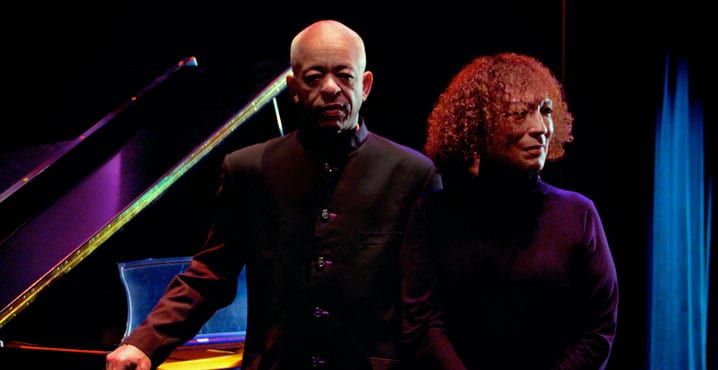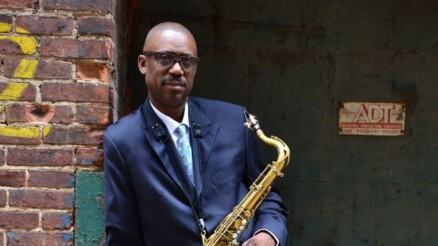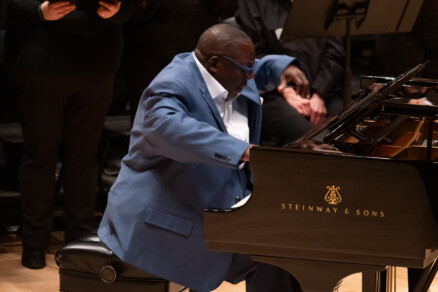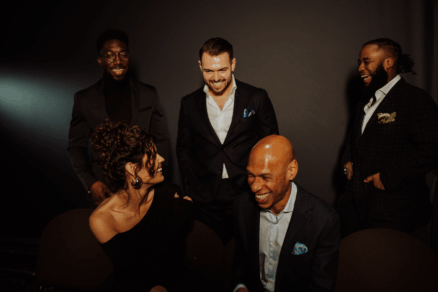Visions of unity and change: Meditating on the AACM with Steve and Iqua Colson

Steve and Iqua Colson perform this Sunday at Bohemian Caverns, as part of Transparent Productions’ Sundays at 7 at the Caverns series.
Steve and Iqua Colson comprise one of the influential families working in the music (sometimes known as “jazz”) in the New Jersey/New York region. Steve Colson is a celebrated pianist with a large body of original work, ranging in format from solo piano to large ensembles. Iqua Colson is a vocalist and composer, recognized by musicians and critics alike for her inventive style.
The two of them are also longtime members of the widely respected AACM, the Association for the Advancement of Creative Musicians. They were not a part of the organization’s founding in the mid-1960s, which was spearheaded by luminaries such as Muhal Richard Abrams, Roscoe Mitchell, Anthony Braxton and many others. Their entry in the early ’70s, however, placed them in the position to inherit the benefits and legacy of a powerful community of creative artists. The Colsons have since become cult-like figures in jazz, finding a place amongst the Afrocentric spiritual jazz ecosystem that has attracted record collectors and aficionados. They have also continued to be key members of the jazz community in Steve’s native region of northern New Jersey, and in New York City, where they remain active within the local AACM chapter and other high-profile performing arts organizations.
The Colsons are in D.C. this Sunday to play at Bohemian Caverns. This recent interview chronicles some of their history with the famous AACM as well as some insight into the overall movement of community organizations.
CapitalBop: Many in the early generation of the AACM eventually moved to New York. From your perspective, how did that move affect the organizational structure?
Steve Colson: In terms of the structure, the musicians a lot of times deal with the reality of promotion. In Chicago, we were playing some very unique and forward-looking music, but the industry, in terms of recording the music, that’s located here on the East Coast. So the record companies and things like that, where people wanted to get more exposure to a wider public opinion and a wider audience, and have their things recorded, they felt as though they had to get out of Chicago to make that happen. Since I’m from the East Coast, I didn’t have that same urgency at the time, just because of my circumstances in Chicago. Actually Iqua and I, because we stayed longer, we didn’t come [to New York] really until ‘82. By that time the Loft Scene was ending, so we kind of missed out on the recording aspect, because a lot of people made their recordings right there between 1977 and 1981. There was about a three or four year window. So when we came at the end of ‘81, we kind of missed that. I will say that the guys that did come out here made a huge impact on the musical scene. Leroy Jenkins, Lester Bowie, Joseph Jarman, and those guys had moved out here. Muhal [Richard Abrams], Threadgill, Fred Hopkins, Steve McCall, and those guys were out this way and they were really shaking things up.
Iqua Colson: At the time, the Loft jazz movement was circulating in New York. When you talk about the structure, you join the AACM in Chicago, and you do the work in Chicago of building and supporting the organizational structure, working with each other to promote the various compositions that you and your colleagues come up with. There were classes where you discuss composition. On Saturday morning, Muhal would be teaching composition. You got to sit there and listen to what Joseph [Jarman] had to say, what [Henry] Threadgill had to say. That structure still exists in Chicago. I’m a Chicagoan, but when I met Steve it was clear we were going to end up [in New York]—it just evolved at a time when it seemed like a good time to make that change, for a lot of people to move to the city.
CB: The AACM was founded as a community organization, dealing with experimental music from the Black community in Chicago. Wouldn’t a move to another place for opportunities and commercial gain go against that mission?
IC: That’s why the organization in Chicago still exists, still has the school, still takes on new members and still does that community work. I think the Jazz Journalists [Association] honored Ann Ward a couple of years ago for specifically that. She’s a fabulous singer and pianist, but she has really developed that school and that community piece there, which is so central to our founding. It wasn’t necessarily that it was Black, because, if you know Chicago—and I grew up there, my family lived on the South Side. My dad was from Englewood, which is where a lot of African Americans came from and went on to do quite well. His high school wall of fame is quite interesting. He also was able to do something different for an African American male at that time, which was to be a scientist. My mother came from Morgan Park, which was a mixed community. Chicago’s South Side, where Dad was and other people were, was Black. Chicago was very segregated. Around 1960 or so, Mom and Dad had divorced. My dad was living on the South Side, and Mom moved into Hyde Park. Hyde Park—which is where a lot of the AACM activity also became central, in terms of concerts and the University of Chicago, being a supporter and presenting music—is one of the few integrated neighborhoods. Obama lives on the street where I grew up. He built a powerful stance with a group of people across color. So I think the AACM grew, the audience and everything, but the musicians were musicians on the South Side, which was a black community. Also it was a way to coalesce and do something different from what was going on in the bars and the clubs. So, on that premise it was founded. The way you came in was through members. It had to be more than one member knowing you and knowing your work, and bringing you in.
SC: The clubs and the places that were ordinary establishments, where you would expect to perform as a musician, those places were kind of restrictive in terms of what the musicians were trying to do at that time, in terms of their own expansion, their own use of their technique, and their own understanding of the music. At that time John Coltrane and Ornette Coleman were really breaking things up in terms of making the new music, so it would be difficult for a person who is really interested in that aspect of the music to get any employment in the establishments that were already there if you went to the Loop, the main business area in downtown Chicago. So the musicians who decided to do this independent work had to find their own outlet, because those places were gonna hire people who were playing in the style of the ’40s. They were playing Charlie Parker songs, Dizzy Gillespie, that type of thing. We respected that music and we might even still play that music. But just in terms of personal evolution as an artist, we had to seek other things and investigate other areas. We started to look out for our own locations.
CB: So you’re saying that even though the AACM was a Black organization, it did not necessarily identify as such?
SC: The membership happened to be African American because, as Iqua said, the city has a long history of [segregation]. I remember when I first got out there I would hear tales about it. Chicago was known to be the most segregated city in the United States. So it would not be unusual for people to be segregated, or put into their own distinct groups. That was just the nature of the city. The AACM itself did have membership other than African-American. Emmanuel Cranshaw was a vibes player in the AACM. He was not Black, and I think some others. I came in around the end of ‘71. The AACM had had a number of members, since it started in ‘65. So a lot of people had passed through there before it gelled into a regular unit of people that were identifiable as AACM members. A number of people came in, and they might stay for a couple of months or whatever, but then they would drift out, because self-sufficiency was involved. When musicians gave concerts, we would move chairs, we would assist in picking up the instruments, we would assist in taking down the microphones, and what have you. It was like a self-help organization as well because we didn’t have the structure of a regular club, and the concept was to not depend on the sale of liquor. It was an entirely different social and environmental structure in terms of what we had to do. So some people would say, “Well I’m a musician. Why am I putting up chairs, and making posters and going to meetings?” So you had a certain group of people that might have been talented, but the organization eventually bore down to 25 or 30 people who could be on a regular basis participating in that kind of thing.
IC:As it turns out, I guess maybe 5 years ago, we got a call from a group in London – Soul Jazz Universal Sound – and they were putting together a book called “Freedom, Rhythm and Sound.” The whole premise of that is about this self-help, do for self movement, which was happening alongside all the controversies – assassinations, civil rights movement of the ‘60s. So Steve and Amiri Baraka had family ties in New Jersey, but once we moved here, [their relationship] had been solidified through their artistic partnership. His movement with the writers and the Black Arts movement, all of that was going on. As I tell my students, artists are sensitive because everything in society is coming through us. We’re mirroring it, we’re reflecting it, we’re documenting it. It’s clear that when that kind of discourse is going on, it’s going to start to show up in the music and the art and so on. I’m not as in touch with some of the original members there who live closer to Chicago – some of our original members like Douglas Ewart. They’re continuing what they’re doing and I’m assuming they’re bringing in new members the way we always did. If their relationships musically begin to cross over racially because of the interest, then that’s just the way things evolve. Of course you see that in concerts here and you probably see that in concerts in Chicago. The only thing is, we don’t bring members in in New York. People have inquired. That’s not our structure. The structure is the homebase, Chicago. Wadada is considered a member of the New York chapter, so is Braxton, even though they’re in Connecticut and California. We’re the satellite and Chicago is where the foundation is, and it continues to be structured that way. I’m not even really privy to what their roster looks like. I don’t know all the individuals.
CB: I’ve always understood the AACM to be connoted as part of what I see as a national Black Arts movement—not simply limited to Amiri Baraka. Would you agree?
SC: Yeah, definitely. There’s a continuum. There is no one person who is carrying anything forward, singularly. Like I said before, at a certain point, it was Ornette Coleman that did things, and Coltrane was investigating similar aspects, but with a different method. Then you had a person like Eric Dolphy, Cecil Taylor, and Sun Ra. There were different individual people that had been presenting an artistic view or framework for other people to look at music and art differently. You don’t find it everywhere. You only find it in certain areas where individuals or people of like minds have decided to pursue that. So the fact that you did have a panoramic kind of thing, in places like Detroit and St. Louis, they would exchange. People like Rasul Siddik and Lester Bowie, they were from St. Louis but were in the AACM. Then in St. Louis, you had Baikida Carroll and Oliver Lake with the Black Artists’ Group. Then the two organizations would bring members from their locations to give concerts. It happened in a lot of places, but it still falls on certain individuals who decided to pursue it. In each case, those situations came up because of some kind of response to a circumstance that is limiting them. So where the artist has been limited, you might find in those examples, the artist has decided to head into the unknown as opposed to reverting to a previous type of situation. A lot of people had listened to John Coltrane and felt like that was the end. He’s taken us as far as we can go. Stop right there and pursue a Coltrane type of interpretation, and let that be your mastery of the art. The AACM as a group of individuals heard John Coltrane, but we pursued something that went beyond that, not to say that anybody is greater than Coltrane. If you listen to the music that’s out now, John Coltrane and those guys in the ‘60’s, you still hear that as the dominating sound in terms of mass media. It is still like Coltrane. That is what has become acceptable. There are people that have not taken that path, so there is some kind of internal motivation for the artist to resist the implications of the now that are trying to restrict them, because convention has set in. People now look at things in a conventional way that previously were radical. Just like Beethoven. When you go to the Symphony, you expect to hear Beethoven, when he actually got a lot of harsh criticism at the time. A lot of artists are up against it in that way. I do think it was indeed a national movement, but you had to have certain individuals with enough fire in the belly to pursue it.
IC:With the Black Arts movement, I always think of a quote from Martin Luther King Jr, that “Longevity has its place.” Steve talked about fire in the belly, that’s probably why people do art anyway. These original [AACM] guys and then us coming in the ’70s, your head is in the place of “I’m pushing change.” In line with Amiri and the Black Arts Movement, you had the AACM deciding that the Art Ensemble would go to Europe carrying the banner of “Great Black Music.” That goes right in line with what Max Roach and Duke Ellington said about calling the music “Jazz.” It does speak volumes to the pushing of something that has come through a culture, and is still evolving and developing, and in the process of redefining, which is what artists should do. You end up with these kinds of banners that are a response to growth and a reaction to what is going on around you. So [the original] guys moved to New York and everything, and started recording on Delmark and Black Saint and so on. But it really can never actually be about commercial pursuit, moreso than it is about expanding opportunity. Everyone has gone in different directions in terms of being composers and what they’ve done, but everyone has cut their teeth together in finding their voice. Henry [Threadgill] and Air and others coming to New York wasn’t so much about opening up commercially, but it was more about plugging into the groundswell at the time.
CB: What does the example of the AACM organization say about the vitality overall of community organizations like this one?
IC: I am involved with a couple of larger more established organizations here in New Jersey. The NJ Performing Arts Center, I sit on their education board. Arts organizations I think struggle overall. There’s always an ebb and flow and a need to redefine purpose. For the AACM, it was founded and still run by musicians. Our goal was to keep the school going, keep the concerts going. I worked with the Museum of Contemporary Art to do a series on the AACM, to include people that left and who were still there. Then we would do big organizational conferences to discuss and teach among each other. We were there and were kind of split during this bridge generation. People like Douglas [Ewart], Ade [Steve Colson], Kahil [El Zabar], me, really it was the four of us that brought everything together and kept a certain kind of vibrancy. Then when we moved here [to New Jersey] the next group kind of took over. They focused on kicking the school up to a higher level. Now, they’re figuring out what the next step is. Ann [Ward] had really taken that school under its wing. We have to wait and see with this next group. They do have some new members – I think Mwata [Bowen]’s son is involved. We just have to kind of stay tuned because its always important to educate young people. That’s one of the bullet points of the organization. Whether its going on in a small way, or under the AACM banner, its hard to say. Given the economics, and the fact that all organizations go through an ebb and flow, the AACM is not gonna be any different, and the history has shown that.
AACM, avant-garde, free jazz, Iqua Colson, jazz, solo piano, Steve Colson




